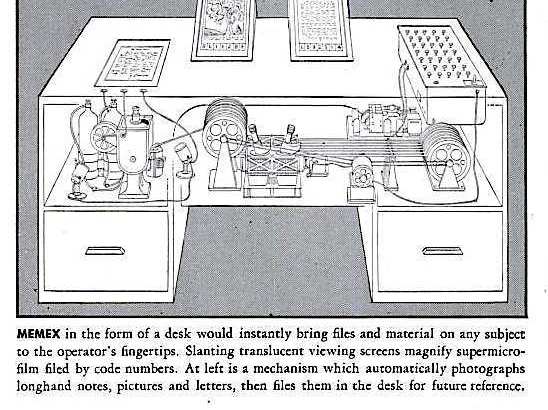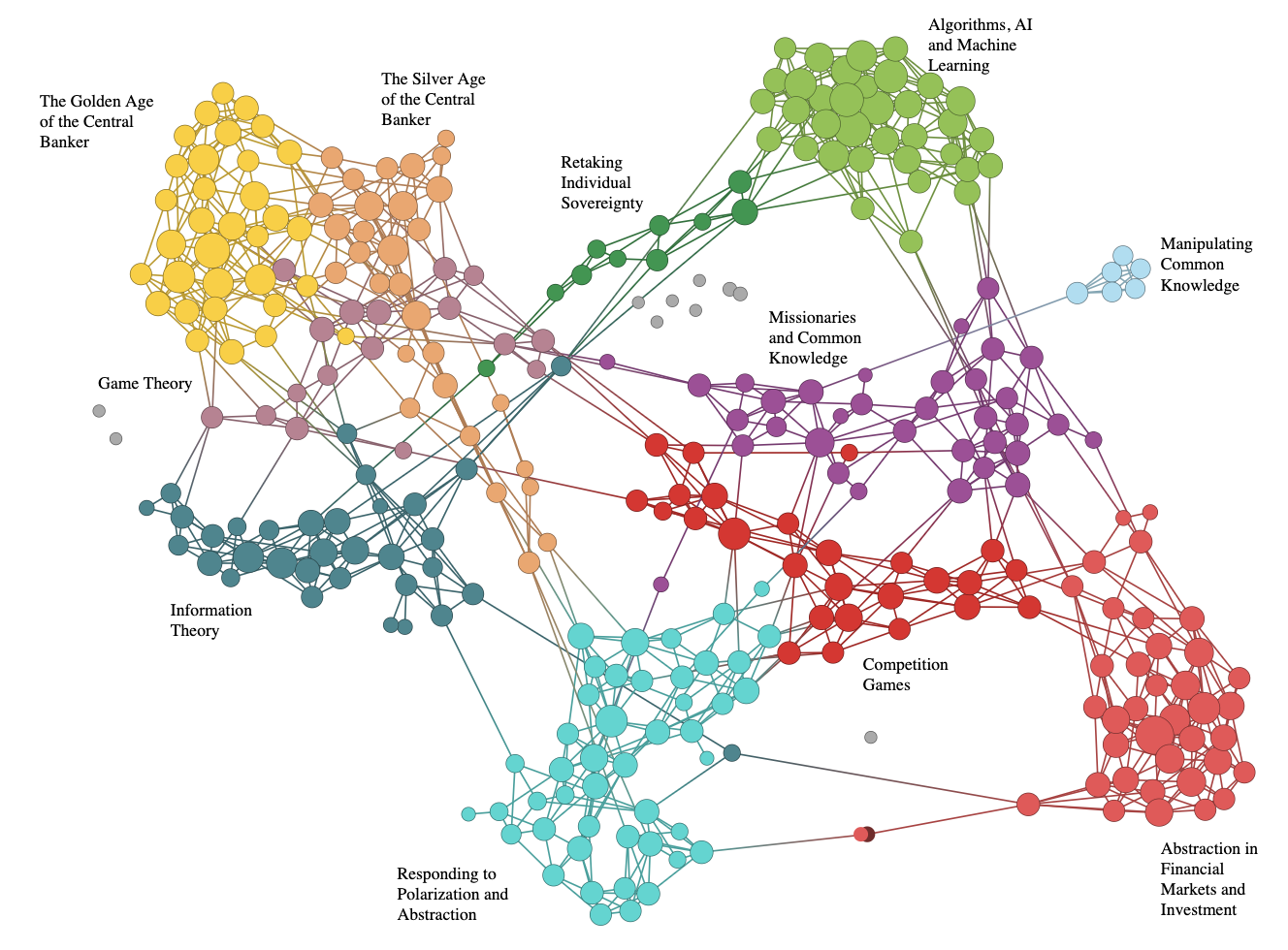The spreading of threading
My Twitter feels like a local library. Each one of my Twitter friends is tending to their own little corner of the internet, sharing their best material, and responding to my random research questions. There are a lot of knowledgable folks out there, but Visakan Veerasamy is the ultimate librarian. I like to think of him as the crown prince of Nerd Twitter — a writer, creator, and curator who’s so prolific he doesn’t recognize himself. Visa is playing the Twitter game on a whole new level. He’s constructing a digital version of his brain, and his curation style feels like an early iteration of something that might one day go mainstream. It’s a knowledge creation and exploration ethos that feels more true to the original “web” and more fit for how we think.
 Visa’s Twitter profile, complete with his personal web of values.
Visa’s Twitter profile, complete with his personal web of values.
Inspired by his huge web of knowledge, I sent out a tweet three months ago that said: “I think I would legit pay for @visakanv as a service. $10/mo for him to respond to all of my random musings with his own thoughts, content recommendations, and links to relevant threads. This service would be like Mario racing turbo boost for the mind!”
To my surprise, Visa responded within a few minutes. “Happy to do this,” he said, and shared a link to his Patreon.
A brief history of tweetstorms
Visa’s digital brain is made up of Twitter threads. He didn’t invent the medium, but he’s pushed it to its limits.
When Marc Andreessen started tweeting in 2014, he didn’t let the 140-character limit stop him from posting his thoughts at length. Instead of shortening his tweets, he started stringing them together by replying to himself. Thus was born the tweetstorm. At first, tweetstorms were a hack. And they were mildly controversial. Gawker once slammed Travis Kalanick’s use of a tweetstorm, calling it “a series of thoughts that give the illusion of substance and circumspection because they are presented in a numerical order.” Tech blogger/investor M.G. Siegler raged against them in 2014:
1/ In theory, 2/ I love Tweetstorms 3/ and have long wanted a feature like this myself. 4/ But in practice, 5/ I f*cking hate them. 6/ They flow in the tweet stream about as nicely as vomit out of an esophagus. 7/ They ruin the experience of the stream by breaking what Twitter is, 8/ a service to share short thoughts quickly 9/ and let others reply to those in some semblance of order.
At first, creating tweetstorms was a very manual process, and they weren’t very easy to read or share. Fast-forward three years: in 2017, Twitter officially productized tweestorms and rebranded them as “threads.” Suddenly, it was much simpler to string tweets together and share the resulting thread as a unit. This product change created the infrastructure on which Visa and others are currently spinning their webs.
Resurrecting the Memex
I found Visa’s threads sometime last year, and I’ve been crawling across them ever since. Whereas Marc Andressen’s threads were mostly self-contained, Visa’s are linked together. They form a giant web of interconnected thoughts. There’s no beginning or ending or map or wayfinding or sense of where you are in his tapestry. There are just threads of threads of threads that seem to extend into infinity — an ever-expanding network of Visa’s ideas and discoveries. At each node, there’s usually a full-on discussion taking place between his followers. Visa has constructed what feels like a whole new medium on top of the bedrock of Twitter. Here’s a representative thread for you to explore:
I’ve been stewing this theory for 1 year +:
— Visa is in SF until May 8! 🌉 (@visakanv) June 6, 2018
Just as how the WWE isn’t a wrestling show, but a show ABOUT a wrestling show,
mainstream media is less about the news than a participatory interactive tv show ABOUT the news
Cable News Network is really Cable News Entertainment https://t.co/QZO2t8I9fI
Visa’s threads are doing to Twitter what hyperlinks did to dead-tree text. They link things together across time and space. Without thread-webs, most tweets get left behind in the past. A web of tweets allows people to rediscover older thoughts and connect them with newer ones.
These threads bear a family resemblance to the vision of an early 20th-century computer pioneer named Vannevar Bush. In 1945, he wrote a now-famous article called As We May Think, which described a knowledge device he called the Memex:
Man cannot hope fully to duplicate [his] mental process artificially, but he certainly ought to be able to learn from it. In minor ways, he may even improve, for his records have relative permanency. The first idea, however, to be drawn from the analogy concerns selection. Selection by association, rather than indexing, may be mechanized. One cannot hope thus to equal the speed of flexibility with which the mind follows an associative trail, but it should be possible to beat the mind decisively in regard to the permanence an clarity of the items resurrected from storage … Wholly new forms of encyclopedias will appear, ready made with a mesh of associative trails running through them, ready to be dropped into the memex and there amplified.

Bush’s vision of associative trails has been realized in some corners of the web, like Wikipedia. But most content is organized in the reverse-chronological stream (also known as the feed or the timeline). Social media sites have made information consumption a very linear process. We scroll down infinitely long pages that are (roughly) organized from newest to oldest. Content that’s more than a week old is fossilized under the endless dump of new posts, links, pictures. On social media, time is the main ordering principle. Creating new content feels like throwing a leaf into a roaring river. It’s not attached to anything — it just floats on by, doomed to be forgotten within a matter of seconds. We don’t really “surf” the web anymore. Unless we’re Wiki-racing, we’re not hopping from hyperlink to hyperlink on a surprising journey across human knowledge. We scroll, click, scroll click.
I see Visa’s Twitter threads as a response to this boring linearity — an attempt to make things hang together. We’re associative beings. We make sense of things by relating them to other things. As Joshua Foer wrote in his book Moonwalking With Einstein: “It takes knowledge to gain knowledge. Memory is like a spiderweb that catches information. The more it catches, the bigger it grows. And the bigger it grows, the more it catches.”
The spread of threads
I’ve noticed that the threading impulse is beginning to expand beyond Twitter. It’s popping up in more and more corners of the web. At Ribbonfarm, Venkatesh Rao is experimenting with a new genre called “blogchains,” in which a bunch of blog posts are linked together around a single theme. It’s different than a traditional series because it’s “improvised rather than planned, is responsive to salient events in the environment, evolves at a certain tempo, is structurally a way to build over time, is suitable for multi-author collaboration, is capable of supporting an inter-process messaging protocol with adjacent blogchains, has no necessary or scripted ‘ending.’” The blogchain seems like a direct descendant of the Twitter thread — an attempt to experiment with the medium outside the confines of Twitter’s more rigid platform.
At Epsilon Theory, Ben Hunt created what he calls a Discovery Map. It’s an interactive visualization that displays all 300 of his blog posts as a network graph. The nodes of the network are organized in thematic clusters. Instead of scrolling down a reverse-chronological feed, you can surf across related posts and see connections across time. This feels like a genuinely new way of interacting with blog content, and it serves as an interesting answer to the question “Where should I start?”

The most interesting non-linear threading product I’ve discovered is called Are.na. It’s like Pinterest, but for nerds. Are.na lets you organize “Blocks” (text, links, photos) into thematic “Channels”. For example, I’m currently collecting material for channels called “designing time” and “wtf is digital selfhood”. Other people can easily add blocks to your channels, and you can include their channels inside your own. Channels can be rearranged, renamed, connected in novel ways. On Are.na, you’re a spider spinning a knowledge web alongside a bunch of other curious spiders. You never know how your webs might connect. I’ve started searching for things on Are.na (instead of Google) because every block lives inside a channel that’s connected to a lot of related content. Whereas a Google search result feels like a dead-end, an Arena block feels like an unexpected beginning.
What’s frustrating about blogging is that each post feels static and final. It’s not very alive as a medium. I wish it were easier for posts to evolve over time, sprout offshoots, find collaborators. The hyperlink is a pretty crude technology for connecting things together. Visa’s threads, Ribbonfarm’s blogchains, Epsilon Theory’s Discovery Map, and Are.na’s channels are all pointing to a model of content creation and consumption that’s more fit for the way our minds actually work. Threads are a more fluid and malleable medium. Finding someone’s thread-web feels like the digital equivalent of perusing the bookshelves in their home. You don’t have to know what you’re looking for, but you’re usually pleasantly surprised by what you find.
For the last few months, Visa has been replying to my tweets with links to his relevant thread-webs. Each random thought I tweet becomes a new entry point into the collection he’s been curating for years. He’d probably do this if I weren’t supporting him on Patreon, but I believe his threading experiment is an extremely valuable service. As the internet grows more complex, we’re going to need people who can string things together across time and challenge the linear assumptions that have dominated online content creation for the last two decades.
If you have comments or questions about this post, feel free to chat with me on Twitter.
Addendum
After tweeting this blog post, Visa (naturally) responded with a link to his thread about threads. It’s a rabbit hole worth exploring.